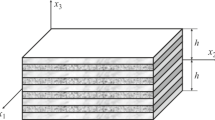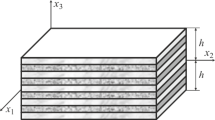For axisymmetrically loaded annular plates rigidly fixed on one edge and statically loaded on the other edge and for rectangular elongated plates subjected to cylindrical bending, we propose a simplified version of the refined theory (model problems) for which the complexity of realization is comparable with the complexity of the Reissner and Reddy theories. Specific calculations are performed for the case of thermoelastoplastic bending of these plates for different levels of thermal action. It is shown that, for relatively thick plates, neither the classical theory, nor the traditional nonclassical Reissner and Reddy theories guarantee the possibility of getting reliable results in finding deflections even under the conditions of rough accuracy equal to 10%. It is shown that, under the conditions of bending of layered metal-composite plates carried out at elevated temperatures in the vicinity of their supporting edges, we observe the appearance of edge effects characterizing the phenomenon of shear of these structures in the transverse direction. The traditional theories characterized by the low orders of approximation of transverse shears do not enable one to detect these local effects, which explains their quite rough accuracy. It is shown that, for the adequate analysis of thermoelastoplastic bending of relatively thin and relatively thick plates for which the materials of the phases of their compositions are linearly elastic, it is sufficient to apply the Reddy theory.
Similar content being viewed by others
References
N. A. Abrosimov and V. G. Bazhenov, Nonlinear Problems of the Dynamics of Composite Structures [in Russian], Nizhegorodskii State University, Nizhnii Novgorod (2002).
S. A. Ambartsumyan, Theory of Anisotropic Plates. Strength, Stability, and Vibration [in Russian], Nauka, Moscow (1987).
A. N. Andreev and Yu. V. Nemirovskii, Multilayer Anisotropic Shells and Plates: Bending, Stability, and Vibration [in Russian], Nauka, Novosibirsk (2001).
V. A. Bazhenov, O. P. Krivenko, and N. A. Solovei, Nonlinear Deformation and Stability of Elastic Shells with Inhomogeneous Structures: Models, Methods, Algorithms, and Poorly Studied or New Problems [in Russian], Librokom, Moscow (2013).
N. I. Bezukhov, V. L. Bazhanov, I. I. Gol’denblat, N. A. Nikolaenko, and A. M. Sinyukov, Strength Analyses, Stability, and Vibration under the Conditions of High Temperatures [in Russian], Mashinostroenie, Moscow (1965).
K. Dekker and J. G. Verwer, Stability of Runge–Kutta Methods for Stiff Nonlinear Differential Equations, North-Holland, Amsterdam (1984).
S. P. Demidov, Theory of Elasticity [in Russian], Vysshaya Shkola, Moscow (1979).
V. G. Zubchaninov, Mechanics of Processes in Plastic Media [in Russian], Fizmatlit, Moscow (2010); English translation: Book on Demand (2015).
D. M. Karpinos (editor), Composite Materials [in Russian], Naukova Dumka, Kiev (1985).
N. N. Malinin, Applied Theory of Plasticity and Creep [in Russian], Mashinostroenie, Moscow (1968).
G. Hall and J. M. Watt, Modern Numerical Methods for Ordinary Differential Equations, Clarendon Press, Oxford (1976).
A. P. Yankovskii, “Modeling of the elastoplastic bending of metallic composite layered plates with regular structures. 1. Structural model,” Vestn. Chuvash. Gos. Ped. Univ. im. Yakovleva, Ser. Mekh. Predel’n. Sostoyan., No. 2 (12), 102–111 (2012).
A. P. Yankovskii, “Modeling of elastoplastic bending of metallic composite layered plates with regular structures. 2. Refined model of deformation,” Vestn. Chuvash. Gos. Ped. Univ. im. Yakovleva. Ser. Mekh. Predel’n. Sostoyan., No. 3 (13), 38–56 (2012).
A. P. Yankovskii, “Refined model of thermoelastoplastic bending of layered plates with regular structure. I. Statement of the problem,” Mat. Met. Fiz.-Mekh. Polya, 61, No. 1, 116–129 (2018); English translation: J. Math. Sci., 249, No. 3, 446–461 (2020).
K. Belkaid, A. Tati, and R. Boumaraf, “A simple finite element with five degrees of freedom based on Reddy’s third-order shear deformation theory,” Mech. Compos. Mater., 52, No. 2, 257–270 (2016).
Author information
Authors and Affiliations
Corresponding author
Additional information
Translated from Matematychni Metody ta Fizyko-Mekhanichni Polya, Vol. 61, No. 2, pp. 111–123, April–June, 2018.
Rights and permissions
About this article
Cite this article
Yankovskii, А.P. Refined Model of Thermoelastoplastic Bending of Layered Plates with Regular Structure. ІІ. Model Problems. J Math Sci 253, 122–135 (2021). https://doi.org/10.1007/s10958-021-05217-5
Received:
Published:
Issue Date:
DOI: https://doi.org/10.1007/s10958-021-05217-5




